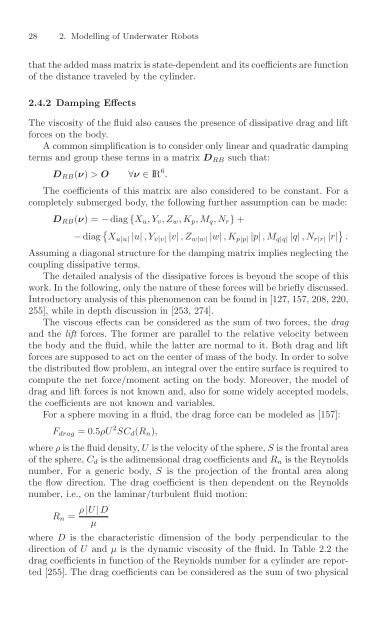Underwater Robots - Gianluca Antonelli.pdf
Underwater Robots - Gianluca Antonelli.pdf
Underwater Robots - Gianluca Antonelli.pdf
You also want an ePaper? Increase the reach of your titles
YUMPU automatically turns print PDFs into web optimized ePapers that Google loves.
28 2. Modelling of <strong>Underwater</strong> <strong>Robots</strong><br />
that theadded mass matrixisstate-dependentand itscoefficients are function<br />
of the distance traveled by the cylinder.<br />
2.4.2 Damping Effects<br />
The viscosity ofthe fluid also causes the presence ofdissipative drag and lift<br />
forces onthe body.<br />
Acommon simplification is to consider only linear and quadratic damping<br />
terms and group these terms in amatrix D RB such that:<br />
D RB( ν ) > O ∀ ν ∈ IR 6 .<br />
The coefficients of this matrix are also considered to be constant. Fora<br />
completely submerged body, the following further assumption can be made:<br />
D RB( ν )=− diag { X u ,Yv ,Zw ,Kp ,Mq ,Nr } +<br />
− diag � X u | u | | u | ,Y v | v | | v | ,Z w | w | | w | ,K p | p | | p | ,M q | q | | q | ,N r | r | | r | � .<br />
Assuming adiagonal structure for the damping matrix implies neglecting the<br />
coupling dissipative terms.<br />
The detailed analysis of the dissipative forces isbeyond the scope ofthis<br />
work. In the following, only the natureoftheseforceswill be briefly discussed.<br />
Introductory analysis ofthis phenomenon can be found in [127, 157, 208, 220,<br />
255], while indepth discussion in [253, 274].<br />
The viscous effects can be considered as the sum of two forces, the drag<br />
and the lift forces. The former are parallel to the relative velocity between<br />
the body and the fluid, while the latter are normal to it. Both drag and lift<br />
forces are supposed toact on the center of mass of the body. Inorder to solve<br />
the distributed flow problem, an integral over the entire surface is required to<br />
compute the net force/moment acting on the body. Moreover, the model of<br />
drag and lift forces isnot known and, also for some widely accepted models,<br />
the coefficients are not known and variables.<br />
Forasphere moving in afluid, the drag force can be modeled as [157]:<br />
F drag =0. 5 ρU 2 SCd ( R n ) ,<br />
where ρ is the fluid density, U is the velocityofthe sphere, S is the frontal area<br />
of the sphere, C d is the adimensional drag coefficients and R n is the Reynolds<br />
number. For ageneric body, S is the projection of the frontal area along<br />
the flow direction. The drag coefficient isthen dependent on the Reynolds<br />
number, i.e., on the laminar/turbulent fluid motion:<br />
R n =<br />
ρ | U | D<br />
µ<br />
where D is the characteristic dimension of the body perpendicular to the<br />
direction of U and µ is the dynamic viscosity ofthe fluid. In Table 2.2 the<br />
drag coefficients in function of the Reynolds number for acylinder are reported<br />
[255]. The drag coefficients can be considered as the sum of two physical






